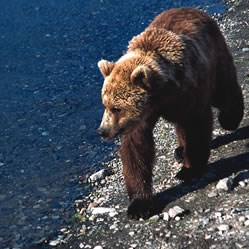
NPS / J. Pfeiffenberger Bears occur throughout Kenai Fjords National Park and are a focal attraction for park visitors. The opportunity to see a bear in its natural habitat contributes significantly to visitor experience. This experience, however, can increase the potential for conflict between humans and bears and alter normal bear behavior. These factors present a management challenge when striving to preserve bears as an integral component of the ecosystem while providing for public safety. In 2009, the Park Superintendent approved an Interim Bear Management Plan to guide bear management in the park. The goals of the park bear management program are to: 1) Provide for visitor and staff safety by minimizing bear-human conflicts. The program consists of proactive measures such as food storage and education, and management actions such as hazing and aversive conditioning of bears. Park visitors assist in bear management by being 'bear smart' which includes hiking with awareness, keeping a clean camp, and filling out Bear Encounter Report forms. Primary responsibility for bear management in the park lies with the Visitor and Resource Protection (VRP) and Resource Management (RM) Teams. The Bear Incident Response Team consists of RM and VRP staff trained to respond to bear incidents. They are the employees you are likely to see in the campground and along the trails monitoring bear activity and educating visitors. Park staff and visitors submit Bear Encounter Reports which provide valuable information on bear activity, which is used to improve visitor safety and to protect bears within the park. Everyone can improve their understanding of bear behavior and minimize negative interactions by understanding the types of interactions that frequently occur. Documented types of encounters include:
Some lessons learned from these interactions include:
Andrew Clark Hecht Memorial Public Safety Achievement AwardThe Kenai Fjords National Park Bear Management Team was awarded the 2008 NPS Andrew Clark Hecht Memorial Public Safety Achievement Award. This award was created in the memory of Andrew Clark Hecht, a nine year old boy who died in 1970 after accidentally falling into a hot spring in Yellowstone National Park. This is the highest award bestowed by the NPS for outstanding public safety achievment and is presented annually by the Director of the National Park Service. This honor is a tribute to all the hard work that has gone into our bear management program at the park. Report Bear EncountersIf you have an encounter with a bear, report it to a park ranger as soon as possible. Questions? Would you like to report an encounter? Contact a visitor center or the Bear Management Team by phone, (907) 422-0500, or email (please include your current contact information). |
Last updated: March 21, 2018
